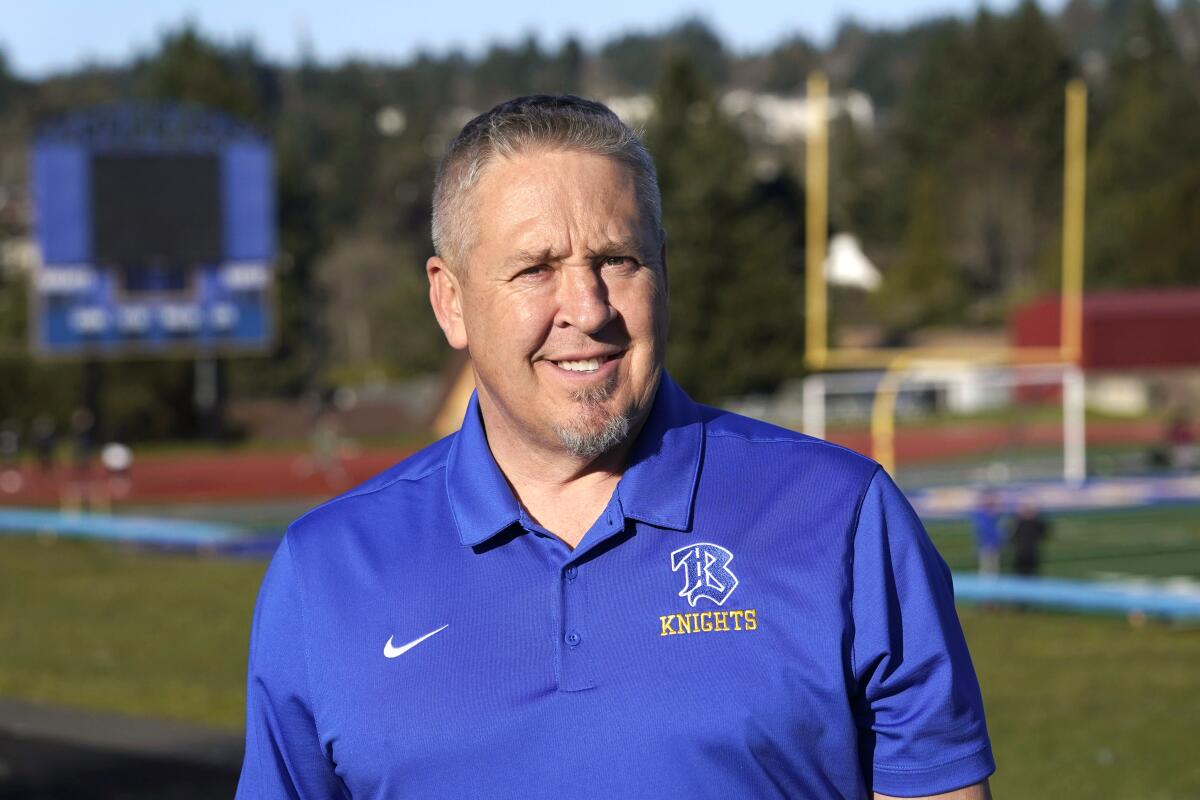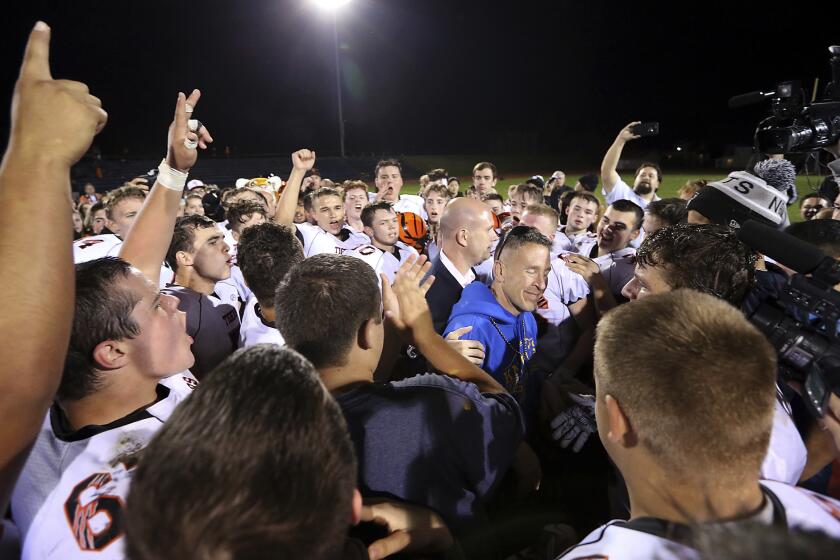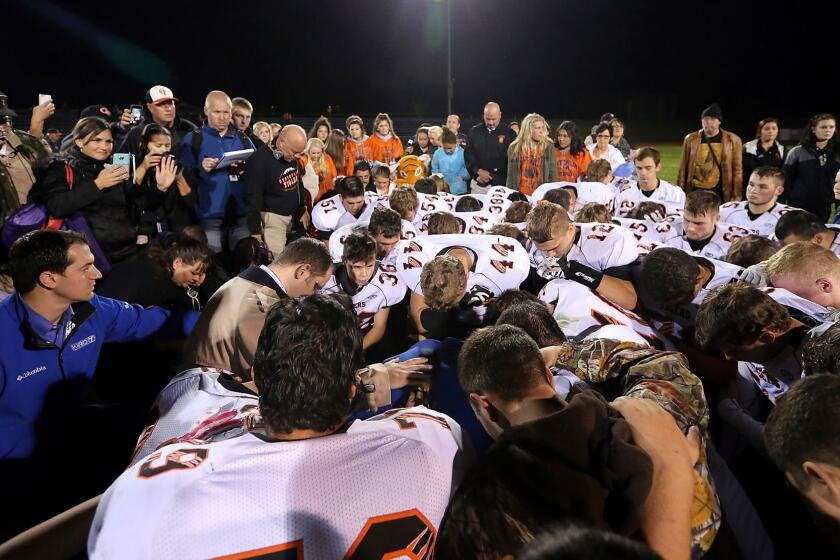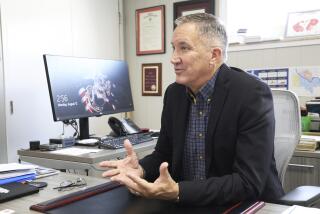Op-Ed: Jesus said to pray in a ‘closet,’ not on the 50-yard line

- Share via
In the 1990s, when Congress was embarking on yet another reckless attempt to legislate public prayer in public schools, the Republican senator from Oregon, Mark O. Hatfield, asked for the floor. Hatfield, an evangelical and lifelong Baptist, testified that he had frequently prayed in school — typically before math tests.
His point was that, contrary to fevered rhetoric to the contrary, neither the Constitution nor the Supreme Court outlawed prayer in schools. The issue was prescribed or compulsory prayer in public schools, an issue that has reared its ugly head once again in a case from Washington state.
Public prayer in public schools should have been dispatched once and for all decades, even centuries, ago, initially by the 1st Amendment — “Congress shall make no law respecting an establishment of religion, or prohibiting the free exercise thereof”— and certainly by Supreme Court rulings in the early 1960s that struck down prescribed prayer and mandatory Bible reading in public education.
Asked to comment on the rulings, which had excited outrage in some quarters, President Kennedy reminded Americans to respect Supreme Court decisions “even when we may not agree with them.”
Supreme Court appears ready to rule for a former high school football coach who said he had a free-speech right to pray at the 50-yard line.
He pointed out the obvious and easy remedy to the situation, “and that is to pray ourselves.”
“I would think,” the president added, “that it would be a welcome reminder to every American family that we can pray a good deal more at home, we can attend our churches with a great deal more fidelity, and we can make the true meaning of prayer much more important in the lives of all our children. That power is very much open to us.”
For Joseph Kennedy (no relation), former high school football coach in Bremerton, Wash., “praying ourselves” wasn’t good enough. After every Bremerton Knights game, Kennedy walked to the 50-yard line, took a knee and offered prayers. Bremerton’s school board, claiming that the prayer sessions came to be seen as mandatory for his players, asked the coach to stop the practice.
Kennedy refused, was removed from his coaching position and filed suit. The Supreme Court heard arguments on the case on Monday. Unfortunately, given the court’s composition and recent rulings (thank you, Mitch McConnell), we have no assurance that the justices will defend the 1st Amendment’s establishment clause and retain the separation of church and state, which has ensured the vitality of religion throughout American history.
As an Episcopal priest, I’d be the last person to gainsay the importance of prayer. But context matters. It matters a lot.
A group that has opposed ethnic studies requirements sued over the In Lak’Ech affirmation, which it claimed constituted a religious prayer.
Any time prayer is compulsory or coercive in a public context, it can violate the establishment clause of the 1st Amendment, which forbids the state from favoring one faith over another (or no faith at all). But it also violates the spirit of prayer itself. Jesus had something to say about the matter. He castigated the religious authorities of his day for their public prayers. He called them hypocrites, “standing in the synagogues and in the corners of the streets” so they could be seen by others.
Jesus, who rarely in the New Testament prayed publicly, instructed his followers instead to “enter thy closet, and ... shut thy door” to pray (King James version, Matthew 6:6). Pray in a closet, not at the 50-yard line.
For the faithful, an even greater danger than coercion is trivialization. Consider Roger Williams, founder of the Baptist tradition in America and the source for the “wall of separation” metaphor that used to be a civic standard. Williams wanted to separate the “garden of the church” from the “wilderness of the world” by means of a “wall of separation.”
Our modern sensibilities about nature hamper our ability fully to understand Williams’ concern. The people of the 17th century did not share our romance with wilderness, which they regarded as a place of danger, where evil lurked. So, when Williams talked about protecting the garden of the church from the wilderness of the world, he was concerned to protect the integrity of the faith from too close an association with politics and the state.
A Christian football coach suspended for kneeling and praying on the 50-yard line after high school games Wednesday lost a bid to be reinstated and allowed to worship in front of students.
Far too often, as with the posting of the Ten Commandments in public spaces, a failure to recognize the importance of the 1st Amendment has led to a devaluation and trivialization of religion. Who can forget, for example, Stephen Colbert’s 2006 interview with Rep. Lynn Westmoreland (R-Ga.), who had co-sponsored a bill to post the Decalogue in both the House and Senate chambers? When Colbert asked him to name the Ten Commandments, Westmoreland stammered, then replied sheepishly, “I don’t know them all.”
The power of religion lies not with coercion but with faith itself. And religion has flourished in the United States as nowhere else precisely because it is uncoerced, precisely because of the 1st Amendment and the separation of church and state. The 1st Amendment set up a free marketplace for religion, where all traditions compete without the state expressing a preference.
Just as Sen. Hatfield had every right to pray silently before a math test, so too Joseph Kennedy, the football coach, has every right to pray. But Jesus suggested that he do so in private, not the middle of a football field as the game ends. The 1st Amendment concurs with that wisdom. For the sake of the integrity of the faith, let’s hope — pray — that the justices will do the same.
Randall Balmer is at work on a biography of Mark O. Hatfield. He is the author of “Solemn Reverence: The Separation of Church and State in American Life.”
More to Read
A cure for the common opinion
Get thought-provoking perspectives with our weekly newsletter.
You may occasionally receive promotional content from the Los Angeles Times.













